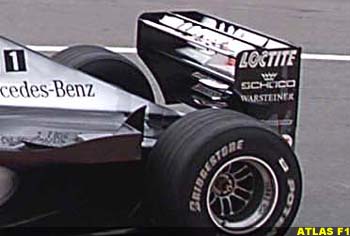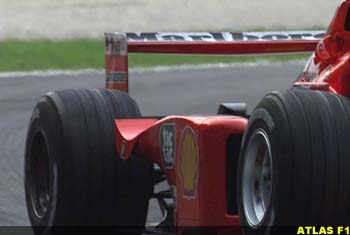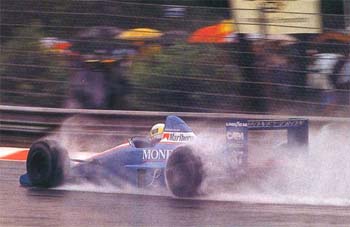|
Atlas F1 presents a series of articles by certified engineer Will Gray, that investigates in greater depth all the technical areas involved in design, development, and construction of a Formula One car.
Part 1: Introduction
Ideally, the only product goal of a Formula One racing car is to win. It is the best combination of all parts of the package which will achieve this, and teams are ever increasing in numbers to keep up with the complex designs required to make it on top of the field. The designers' aim is to make the car the fastest through every corner, and along every straight of every lap, then strategy, reliability, driver ability and luck all play a part in securing that win. There are many factors which must be considered in designing one of these highly complex machines.
The basics of the car are a monocoque chassis, bodywork, suspension, engine and wheels. The designer must optimise and compromise in all these areas to get the best design the team's ability and budget can create. The car must cope with the intense loadings created at Formula One speeds - in taking each corner on the race circuit, the car will experience positive and negative g-forces in all directions, and the more loading the car can cope with, the faster it can go around the track. The car has a limit, and this is its design limit. Take it above that and you're in the barrier. No matter who the driver is, once the car reaches its limit, it won't go faster - put Michael Schumacher in a Minardi and although he may be able to take it closer to its limit than others, he still won't put it on the podium because its design is limiting its speed.
The most critical area, and one race engineers always look at, is the tyre loadings. As the wheels are the only point of contact between race-car and circuit, these are incredibly important. It is here that the power is laid down (rear wheels), and the steering direction is input (front wheels). The designer requires the tyre to be in contact with the road at all times, and this is achieved through two means - Aerodynamic, and Mechanical grip. The suspension provides the mechanical grip, through spring and damper settings, and the aero grip comes from directing the airflow to create a downward force.
Many days are spent in the wind tunnel optimising the aero package with the aim of achieving the most downforce for the least drag. By optimising both the aero and the mechanical areas, the handling is optimised, the driver will be able to attack the corners without fear of understeer (where the car will drift wide) or oversteer (where the car turns in too sharply and the rear end snaps out), and he will have confidence in the car. Once the car is designed, the art of setting the mechanical and aero grip is in the hands of the race engineer. He can alter settings on the car (flap settings for aero, and damper and roll settings for mechanical), to aim for the set-up which suits the driver best.
The driver, of course, plays a crucial part in the package. As explained before, if he is not happy with the car, it will be more difficult to get the best performance out of it. As well as its handling, the driver is concerned with comfort and safety in the car. Safety is paramount now, and advances in the last five years have saved lives. The area of Human Factors - the relationship between man and machine - is playing an increasing part in Formula One as technology levels increase and allow improvements. The development of the semi-automatic gearbox, which allows the driver to change gear without using the clutch and without removing his hands from the steering wheel, has been a significant development in this area, and now the wheels are filled with buttons and switches.
All these switches and buttons help the driver to control certain parts of the car, but the two pedals at his feet are where it's at. Accelerating and braking, along with steering, are the actions which determine whether a car wins or comes in three laps down in last place. The acceleration and braking in a Formula One car are second to none. Braking is often in the news, with short braking distances being one of the causes of the current overtaking deficiency in Formula One, and overheating brakes causing several accidents in 1999.
Above all else, however, power is everything in modern Formula One - without raw grunt, you don't get anywhere! The influx of interest from major car manufacturers can only serve to make the area of engine design more competitive. The engine is one of the most important parts of the package, and its design in recent years has concentrated on weight and size reduction as well as increasing power.
This brings us to another important area - weight and weight distribution. A car will handle best with a low centre of gravity. Cars are all designed with weights below the minimum weight required. This then allows the teams to put ballast where they want it, to achieve the best weight distribution and the best position for the centre of gravity.
From this discussion, it is clear that the modern Formula One car is not a simple object. The complexity and accuracy of the design requires much money, time, and personnel to perfect - but one cannot use the word 'perfect', for a Formula One car is never perfected. Continuous development is required to keep up with the rest, and if you stand still for a week, you've lost essential hundredths of a second to your competitors. Parts are improved all the time, most teams have at least two or three specifications of engine per year, and the car at the end of the year can be a very different beast to that which began the campaign. The job of the Formula One engineer is never complete.
Part 2: Circuits, Conditions, and Complications
A Formula One car is required to perform at its limit in a massive number of different situations. This presents enormous problems for designers, race engineers and drivers alike. In designing, setting up, and racing a car, there are many factors to take into consideration, such as track design, temperature, wind speed, etc.
Of the sixteen races on the Formula One calendar, all can be categorised, but none can be called 'similar'. Circuits are put into sections of High, Medium, and Low Downforce. This definition is made from looking at the circuits' characteristics - their different combinations of corners and straights.
 Take, for example, a place like Monaco. This is a high downforce circuit - meaning average speeds tend to be low, and corners tend to be sharp and plentiful. The place, due to its very nature as what is effectively a race through the middle of town (all be it a very special town) is made up of sharp corner after sharp corner, split up mostly by short straights. Getting speed through the corners here is more critical than being fast down the straights, and that means downforce is needed in abundance. Therefore, Monaco is traditionally the place where all the teams' gismos are on the cars. Every area is explored to obtain any tiny amount of downforce possible, and all the extra downforce producing devices developed in the wind tunnel tests come into play here. Cars sprout winglets, more wings, and, at one time, sidepod wings. The teams lump so many elements on the rear wing of the car that the wing mirrors are rendered useless! Take, for example, a place like Monaco. This is a high downforce circuit - meaning average speeds tend to be low, and corners tend to be sharp and plentiful. The place, due to its very nature as what is effectively a race through the middle of town (all be it a very special town) is made up of sharp corner after sharp corner, split up mostly by short straights. Getting speed through the corners here is more critical than being fast down the straights, and that means downforce is needed in abundance. Therefore, Monaco is traditionally the place where all the teams' gismos are on the cars. Every area is explored to obtain any tiny amount of downforce possible, and all the extra downforce producing devices developed in the wind tunnel tests come into play here. Cars sprout winglets, more wings, and, at one time, sidepod wings. The teams lump so many elements on the rear wing of the car that the wing mirrors are rendered useless!
At the other extreme, the faster circuits have a very different requirement in the downforce-drag trade-off. With long straights and sweeping corners, the teams want higher maximum speed out of the cars, and don't need as much downforce. So they run less wing, may use flick-ups instead of winglets, and don't need to use the more inefficient means of obtaining downforce. The car's top speed will increase significantly, as it has less area to pull through the air.
 However, it is not only the aerodynamics which must be considered when looking at different circuits. With the short straights of a high downforce circuit, acceleration must be quick, so that a reasonably high speed may be attained before reaching the end of the straight. The 'short blip' of acceleration on a straight is obtained by having an engine with good 'low end power' (powerful at low speeds), and a low gear ratio. Generally, gears are such that they can be set up for maximum acceleration, or maximum top speed, but not for both. This means a different set-up again at the fast circuits, where top speed is more critical, and low end power takes a back seat. However, it is not only the aerodynamics which must be considered when looking at different circuits. With the short straights of a high downforce circuit, acceleration must be quick, so that a reasonably high speed may be attained before reaching the end of the straight. The 'short blip' of acceleration on a straight is obtained by having an engine with good 'low end power' (powerful at low speeds), and a low gear ratio. Generally, gears are such that they can be set up for maximum acceleration, or maximum top speed, but not for both. This means a different set-up again at the fast circuits, where top speed is more critical, and low end power takes a back seat.
Then there's suspension. Not so much a high/low downforce issue here as a bumps consideration. The Interlagos circuit in Brazil is renowned for its bumps, and a car here has a very different suspension and damper set-up to one at a smooth circuit such as Silverstone, simply to cope with the track surface.
All these complications show that this F1 lark is no piece of cake! No set-up is the same, and even at the same circuit the following year, the car is different, so previous set-ups can only be used as a guide. Circuit design has implications for all the areas of design we shall be looking at.
So too do the elements. Formula One circuits are outdoor arenas, and that is unlikely to change in the near future! For this reason, the Formula One engineer must cope with that most unpredictable of entities - the weather.  Now we consider this factor, we see that not even the circuit is ever the same - it just gets worse for the F1 engineer! The most obvious weather factor is rain. The car has a completely different set-up in the wet to that in the dry, and in some races, it has been those who spot it coming that take the advantage of using a different set-up and go on to win. This is why all the top teams now have their own weather stations - and some even post team members at different parts of the circuit, or in a circling helicopter if the weather looks threatening. Now we consider this factor, we see that not even the circuit is ever the same - it just gets worse for the F1 engineer! The most obvious weather factor is rain. The car has a completely different set-up in the wet to that in the dry, and in some races, it has been those who spot it coming that take the advantage of using a different set-up and go on to win. This is why all the top teams now have their own weather stations - and some even post team members at different parts of the circuit, or in a circling helicopter if the weather looks threatening.
But it is not only the rain which affects the race car. Track temperatures can play havoc with the tyres, as they have very specific operating temperatures and give different levels of grip in different conditions. Wind can be a problem too. As Damon Hill has often complained about the current crop of narrow Formula One cars, you can test in the morning and be fine, then with a wind shift, the car won't handle at all well in the corners it was fine on earlier! The side wind problem is tested to a point in the wind tunnel, but it is very difficult to cope with at the track and some cars are more resilient to it than others.
Different circuits and different conditions present challenges for all connected with the engineering side of Formula One, and it is those who predict and cope best with these complications who eventually triumph.
Next Week: Part 3 - Performance Requirements
|

